                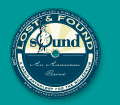
|
 |

Produced by The Kitchen Sisters (Nikki Silva & Davia Nelson), with Laura Folger. Mixed by Jim McKee.
Listen to the story as heard on NPR's All Things Considered.
View a photo gallery on Chinatown's funeral rituals and rites.
View a photo gallery on the Cathay Band's history.
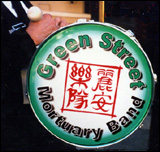
|
Following Chinese tradition, San Francisco's Green Street Mortuary Band provides the spirits of Chinatown's dead with a musical sendoff.
Photo: Laura Folger
|
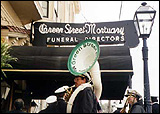
|
The band warms up outside the mortuary.
Photo: L. Folger
|
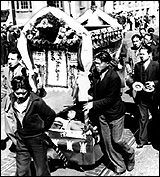
|
A Chinatown funeral procession, circa 1938.
Photo courtesy San Francisco Public Library
|
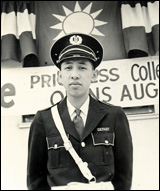
|
Cathay Band member Wilson Wong in his uniform. The Green Street Mortuary Band continues the San Francisco tradition started by the Cathay Band.
Photo courtesy Wilson Wong
|
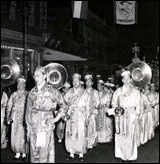
|
The Cathay Band performs in a Chinatown New Year's parade, circa 1940.
Photo courtesy W. Wong
|
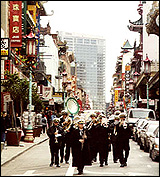
|
The Green Street Mortuary Band leads a funeral up Chinatown's Grant Avenue.
Photo: L. Folger
|
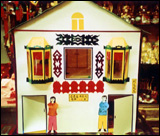
|
Purchased by mourners from "paper shops," paper replica constructions of "necessary" goods and items are displayed at funeral gatherings as offerings to the dead for their use in the afterworld. Gifts of paper clothing, toothpaste and servants are accompanied by desirable modern consumer durables, such as VCRs, mobile telephones, Mercedes and radios.
Photo: L. Folger
|
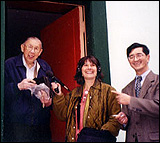
|
Weylin Eng, right, and Wilson Wong meet after 30 years by coincidence outside the Cathay Clubhouse on Commercial Street in San Francisco's Chinatown. In between the two, recording, Nikki Silva.
Photo: L. Folger
|
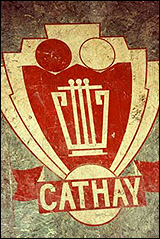
|
The emblem of the Cathay Club is featured in linoleum on the main floor of the social club.
Photo: L. Folger
|
Oct. 3, 2003 -- Lawrence Ferlinghetti wrote a poem about them. Novelist Amy Tan's mother was serenaded by them as she lay in state. Muckraker Jessica Mitford's memorial procession was led by them. And more than 300 Chinese families a year hire the Green Street Mortuary Band to give their loved ones a proper and musical send-off through the streets of Chinatown.
The band traces its roots back to 1911 and the Cathay Chinese Boys Band, the first marching group in Chinatown. For more than 50 years, this amateur band performed for its community at nearly every big event: Chinese New Year's, the opening of the Golden Gate Bridge, Confucius' Birthday, the 1939 World's Fair and many elaborate funeral processions.
In the 1940s, the San Francisco musicians' Local 6 pressed the mortuaries to hire union musicians for the steady work the funeral processions provided. At the same time, the mortuaries of Chinatown began to close and the neighborhood began to take its funerals to Green Street, the Italian funeral parlor in North Beach. The Green Street Mortuary Band was born. Today, the legendary Green Street Band continues to accompany the ritual funeral processions that snake through Chinatown, honoring the dead with Christian hymns, dirges and marches, scaring off evil spirits along the route with crashing cymbals and loud drums, helping families give their loved ones a noisy farewell.
Interview Excerpts:
Bill Steiner, General Manager of the Green Street Mortuary
"What makes us distinct is our huge Chinese clientele, also our location here in the Chinatown North Beach area of San Francisco. We do things quite a bit differently. All of the Chinese traditions are observed, the burning of the incense, the blanketing, the burning of the paper houses, cars, the marching band -- it's quite different than traditional funerals in, you know, in America.
"Forty years ago and more there was more of a division of Chinatown, where the old timers said that Broadway was the line that separated Chinatown from North Beach. This was the Valenti Muni Parada Mortuary -- predominantly Italian clientele at the time. Then as times changed, the population grew, and Vilenti Muni Parada left, and the new owner contacted the different associations and the ministers, and pursued the Chinese clientele."
Camilia Lau, Green Street Mortuary Employee
"I'm a counselor. I work here only 10 years. The Asian people, the casket they pay a lot of money for those and they want to do something fancy. The casket they call the Big House. Because that the last we do for the parents or the lover. We give them the last big house and they live there forever. That's the tradition. I would say 30 percent, they order the band, it's not cheap. It costs almost $800."
Weylin Eng, the Early Days of the Cathay Band
"My father, Raymond Eng, was an active member in the band and took me along to band rehearsals and also to join the parades. There were at least 50 or 60 people that played. They were a group made up of attorneys, doctors, butchers, electricians, insurance people. People from just across the spectrum of the Chinese-American community. It was just as much a social club as it was a music club. And everyone knew everyone else. Not only in the band but outside because when we marched through Chinatown, people would yell, 'Hey Ray, hey Tom.' It was just as much a social club as it was a music club."
"By the time the Cathay Band got to the '60s, so many of the people who would normally play an instrument had moved out of the area and into suburbia and probably had lost interest and was just hard to come in. And the need for that social interaction became less and less as they got into mainstream America."
Clifford Yee, Former Director of the Green Street Mortuary
"Grant Avenue is the very first street that started Chinatown. Back to the gold rush days, Grant Avenue was called Bo Bon Guy and that was the only street that Chinatown had. We were restricted to a 23-square block area. So what Chinatown did is they made all these different alleyways along the way to expand the area that we have... There's an old Chinese superstition that if the spirit is chasing us, we run down, make a sharp right or a sharp left, the spirit can't follow us -- only goes straight."
Yee on the Funeral Procession Route
"A typical route that we will go through that covers roughly about 12 blocks. We go right on Stockton all the way to Clay Street. We make a left on Clay one block and then a right on Grant Avenue. When we come up to the next intersection of Clay and Grant, we'll see a lot of tourists come out and take pictures. And a lot of them will make the sign of the cross just out of their heart which is kind of nice. As we walk through Chinatown, we'll see a lot of different families that we served. And they'll recognize the band. And again they'll stop and pay their respects."
Linda Sun Crowder, Cultural Anthropologist, on Rituals for the Dead
"Within China, there's always been this tradition of offering things to the spirit because in their view, the spirit world is a parallel reflection of the physical world. If you needed a house, car, TV, servants in this life, you will surely need them in the next. So a whole cottage industry has developed of Chinese paper funeral goods for burning. There are karaoke sets, TV sets, a chest full of paper clothes, watches, all to be consumed at the grave in flames. Often they'll have a paper bridge with the idea that this is for the spirit to cross over into the spirit world. It's usually the Buddhists and the Taoists that burn."
"Sometimes they will actually pack real food in the casket and people will put in a mirror to show the way or flashlight. For instance, a blanket ceremony -- placing blankets over the corpse as if for a last sleep. Or just personal items, a golf club. I've often seen people place a pre-1964 dime in the mouth to symbolize wealth and to pay their way through the spirit world. The reason they use a 1964 dime or earlier is because it has a higher silver content."
Crowder on Traditions and Discrimination
"For most of its existence, Chinatown and [its inhabitants] were very discriminated against. But as part of that discrimination, the Chinese were kind of left to themselves. The merchants of Chinatown were the leaders. They had their agreements with City Hall that they would take care of Chinatown and so City Hall sort left Chinatown to its over devices. And that explains partly why traditions have been able to be maintained in Chinatown."
Special Thanks:
Wilson Wong, Raymond O. Lym, William Chan, Weylin Eng, Dr.Helen Eng, Reverend Ben Chin, Johnny Coppola, Lisa Pollard, Willard Spencer and all the members past and present of the Cathay Band and the Green Street Mortuary Band, Bill Steiner, Clifford Yee, Camilia Lau , Pansy Moy, Jeannie Woo and the Chinese Historical Society, Felicia Lowe, Lawrence Ferlinghetti, Amy Tan, Ruxandra Guidi, and Lost & Found Sound intern Jonah Platt-Ross.
Web Resources
Green Street Marching Band
Lawrence Ferlinghetti's poem, 'The Green Street Mortuary Band'
Historic Chinatown funeral film
Chinese Historical Society
Cathay Band archival photos from the San Francisco Public Library
San Francisco's Chinatown.com
You need the free RealAudio player to listen to audio files.
Copyright © 2003 The Kitchen Sisters
|
|
|



